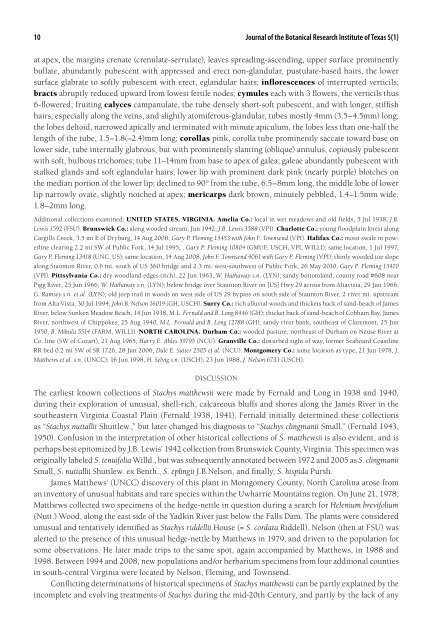(Stachys: Lamiaceae) from the - Botanical Research Institute of Texas
(Stachys: Lamiaceae) from the - Botanical Research Institute of Texas
(Stachys: Lamiaceae) from the - Botanical Research Institute of Texas
Create successful ePaper yourself
Turn your PDF publications into a flip-book with our unique Google optimized e-Paper software.
10 Journal <strong>of</strong> <strong>the</strong> <strong>Botanical</strong> <strong>Research</strong> <strong>Institute</strong> <strong>of</strong> <strong>Texas</strong> 5(1)<br />
at apex, <strong>the</strong> margins crenate (crenulate-serrulate), leaves spreading-ascending, upper surface prominently<br />
bullate, abundantly pubescent with appressed and erect non-glandular, pustulate-based hairs, <strong>the</strong> lower<br />
surface glabrate to s<strong>of</strong>tly pubescent with erect, eglandular hairs; inflorescences <strong>of</strong> interrupted verticils;<br />
bracts abruptly reduced upward <strong>from</strong> lowest fertile nodes; cymules each with 3 flowers, <strong>the</strong> verticils thus<br />
6-flowered; fruiting calyces campanulate, <strong>the</strong> tube densely short-s<strong>of</strong>t pubescent, and with longer, stiffish<br />
hairs, especially along <strong>the</strong> veins, and slightly atomiferous-glandular, tubes mostly 4mm (3.5–4.5mm) long;<br />
<strong>the</strong> lobes deltoid, narrowed apically and terminated with minute apiculum, <strong>the</strong> lobes less than one-half <strong>the</strong><br />
length <strong>of</strong> <strong>the</strong> tube, 1.5–1.8(–2.4)mm long; corollas pink, corolla tube prominently saccate toward base on<br />
lower side, tube internally glabrous, but with prominently slanting (oblique) annulus, copiously pubescent<br />
with s<strong>of</strong>t, bulbous trichomes; tube 11–14mm <strong>from</strong> base to apex <strong>of</strong> galea; galeae abundantly pubescent with<br />
stalked glands and s<strong>of</strong>t eglandular hairs; lower lip with prominent dark pink (nearly purple) blotches on<br />
<strong>the</strong> median portion <strong>of</strong> <strong>the</strong> lower lip; declined to 90° <strong>from</strong> <strong>the</strong> tube, 6.5–8mm long, <strong>the</strong> middle lobe <strong>of</strong> lower<br />
lip narrowly ovate, slightly notched at apex; mericarps dark brown, minutely pebbled, 1.4–1.5mm wide,<br />
1.8–2mm long.<br />
Additional collections examined: UNITED STATES. VIRGINIA. Amelia Co.: local in wet meadows and old fields, 5 Jul 1938, J.B.<br />
Lewis 1592 (fSu). Brunswick Co.: along wooded stream, Jun 1942, J.B. Lewis 3588 (VPi). Charlotte Co.: young floodplain forest along<br />
cargills creek, 3.5 mi e <strong>of</strong> dryburg, 14 Aug 2008, Gary P. Fleming 15453 with John F. townsend (VPi). Halifax Co.: moist swale in powerline<br />
clearing 2.2 mi Sw <strong>of</strong> Public fork, 14 Jul 1995, , Gary P. Fleming 10804 (gmuf, uSch, VPi, willi); same location, 1 Jul 1997,<br />
Gary P. Fleming 13418 (unc, uS); same location, 14 Aug 2008, John F. townsend 4061 with Gary P. Fleming (VPi); thinly wooded toe slope<br />
along Staunton river, 0.6 mi. south <strong>of</strong> uS 360 bridge and 2.3 mi. west-southwest <strong>of</strong> Public fork, 26 may 2010, Gary P. Fleming 15470<br />
(VPi). Pittsylvania Co.: dry woodland edges (rich), 22 Jun 1963, W. hathaway s.n. (lYn); sandy bottomland, county road #608 near<br />
Pigg river, 25 Jun 1966, W. hathaway s.n. (lYn); below bridge over Staunton river on [uS] hwy 29 across <strong>from</strong> Altavista, 29 Jun 1966,<br />
G. ramsey s.n. et al. (lYn); old jeep trail in woods on west side <strong>of</strong> uS 29 bypass on south side <strong>of</strong> Staunton river, 2 river mi. upstream<br />
<strong>from</strong> Alta Vista, 30 Jul 1994, John B. nelson 16019 (gh, uSch). Surry Co.: rich alluvial woods and thickets back <strong>of</strong> sand-beach <strong>of</strong> James<br />
river, below Sunken meadow Beach, 14 Jun 1938, m.L. Fernald and B. Long 8446 (gh); thicket back <strong>of</strong> sand-beach <strong>of</strong> cobham Bay, James<br />
river, northwest <strong>of</strong> chippokes, 25 Aug 1940, m.L. Fernald and B. Long 12788 (gh); sandy river bank, sou<strong>the</strong>ast <strong>of</strong> claremont, 25 Jun<br />
1950, B. mikula 5514 (fArm, willi). NORTH CAROLINA. Durham Co.: wooded pasture, nor<strong>the</strong>ast <strong>of</strong> durham on neuse river at<br />
co. line (Sw <strong>of</strong> cozart), 21 Aug 1965, harry e. ahles 59795 (ncu). Granville Co.: disturbed right <strong>of</strong> way, former Seaboard coastline<br />
rr bed 0.2 mi Sw <strong>of</strong> Sr 1726, 28 Jun 2006, Dale e. suiter 2505 et al. (ncu). Montgomery Co.: same location as type, 21 Jun 1978, J.<br />
mat<strong>the</strong>ws et al. s.n. (uncc); 16 Jun 1998, h. selvig s.n. (uSch); 23 Jun 1988, J. nelson 6733 (uSch).<br />
discussion<br />
<strong>the</strong> earliest known collections <strong>of</strong> stachys mat<strong>the</strong>wsii were made by fernald and long in 1938 and 1940,<br />
during <strong>the</strong>ir exploration <strong>of</strong> unusual, shell-rich, calcareous bluffs and shores along <strong>the</strong> James river in <strong>the</strong><br />
sou<strong>the</strong>astern Virginia coastal Plain (fernald 1938, 1941). fernald initially determined <strong>the</strong>se collections<br />
as “stachys nuttallii Shuttlew.,” but later changed his diagnosis to “stachys clingmanii Small,” (fernald 1943,<br />
1950). confusion in <strong>the</strong> interpretation <strong>of</strong> o<strong>the</strong>r historical collections <strong>of</strong> s. mat<strong>the</strong>wsii is also evident, and is<br />
perhaps best epitomized by J.B. lewis’ 1942 collection <strong>from</strong> Brunswick county, Virginia. this specimen was<br />
originally labeled s. tenuifolia willd., but was subsequently annotated between 1972 and 2005 as s. clingmanii<br />
Small, s. nuttallii Shuttlew. ex Benth., s. eplingii J.B.nelson, and finally, s. hispida Pursh.<br />
James mat<strong>the</strong>ws’ (uncc) discovery <strong>of</strong> this plant in montgomery county, north carolina arose <strong>from</strong><br />
an inventory <strong>of</strong> unusual habitats and rare species within <strong>the</strong> uwharrie mountains region. on June 21, 1978,<br />
mat<strong>the</strong>ws collected two specimens <strong>of</strong> <strong>the</strong> hedge-nettle in question during a search for helenium brevifolium<br />
(nutt.) wood, along <strong>the</strong> east side <strong>of</strong> <strong>the</strong> Yadkin river just below <strong>the</strong> falls dam. <strong>the</strong> plants were considered<br />
unusual and tentatively identified as stachys riddellii house (= s. cordata riddell). nelson (<strong>the</strong>n at fSu) was<br />
alerted to <strong>the</strong> presence <strong>of</strong> this unusual hedge-nettle by mat<strong>the</strong>ws in 1979, and driven to <strong>the</strong> population for<br />
some observations. he later made trips to <strong>the</strong> same spot, again accompanied by mat<strong>the</strong>ws, in 1988 and<br />
1998. Between 1994 and 2008, new populations and/or herbarium specimens <strong>from</strong> four additional counties<br />
in south-central Virginia were located by nelson, fleming, and townsend.<br />
conflicting determinations <strong>of</strong> historical specimens <strong>of</strong> stachys mat<strong>the</strong>wsii can be partly explained by <strong>the</strong><br />
incomplete and evolving treatments <strong>of</strong> stachys during <strong>the</strong> mid-20th century, and partly by <strong>the</strong> lack <strong>of</strong> any
















